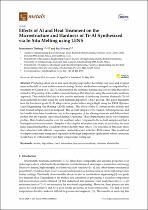 ResearchSpace
ResearchSpace
Effects of A1 and heat treatment on the microstructure and hardness of Ti-A1 synthesized via in situ melting using LENS
JavaScript is disabled for your browser. Some features of this site may not work without it.
- ResearchSpace
- →
- Research Publications/Outputs
- →
- Journal Articles
- →
- View Item
| dc.contributor.author |
Tlotleng, Monnamme

|
|
| dc.date.accessioned | 2019-12-18T09:54:15Z | |
| dc.date.available | 2019-12-18T09:54:15Z | |
| dc.date.issued | 2019-05 | |
| dc.identifier.citation | Tlotleng, M. & Pityana, S.L. 2019. Effects of A1 and heat treatment on the microstructure and hardness of Ti-A1 synthesized via in situ melting using LENS. Metals, 9(6), 623, pp. 1-13 | en_US |
| dc.identifier.issn | 2075-4701 | |
| dc.identifier.uri | https://www.mdpi.com/2075-4701/9/6/623 | |
| dc.identifier.uri | https://doi.org/10.3390/met9060623 | |
| dc.identifier.uri | http://hdl.handle.net/10204/11271 | |
| dc.description | This is an open-access article distributed under the Creative Commons Attribution License which permits unrestricted use, distribution, and reproduction in any medium provided the original work is properly cited. | en_US |
| dc.description.abstract | Producing alloys via in-situ laser alloying approach is becoming very easy and a topical issue in the field of laser additive manufacturing. Several studies have emerged, accompanied by a statement by Gasper et al. (2017), who reported the economic benefits and cost savings that can be related to 3D printing of the additive manufacturing (AM) structure using the said in situ synthesis approach. They studied the laser in situ reactive synthesis of producing titanium aluminide (Ti–Al) from elemental powders using the laser materials deposition (LMD) process. This paper highlights how the functional grade Ti–Al alloys can be produced in a single flight using the 850-R Optomec Laser Engineering Net Shaping (LENS) system. The effects of the Al content in the as-built and heat-treated samples were investigated. The as-built samples were cracked, inhomogeneous, and had visible inter-layer boundaries due to the segregation of the alloying elements and different heat profiles that are typically experienced during 3D printing. These characteristics led to wavy hardness profiles. Heat-treated samples were the least hard when compared to the as-built samples and had a homogenized microstructure. Samples with a duplex microstructure were, in particular, the least hard, indicating that they would have better ductility than others. The outcomes of this study show that a structure with different composition can be fabricated with the LENS system. This would lead to adaptive structures being used, especially in the high temperature applications where a structure would have to withstand low and high temperatures during use. | en_US |
| dc.language.iso | en | en_US |
| dc.publisher | MDPI | en_US |
| dc.relation.ispartofseries | Workflow;22798 | |
| dc.subject | Deposition | en_US |
| dc.subject | In-situ | en_US |
| dc.subject | Laser | en_US |
| dc.subject | Microstructure | en_US |
| dc.subject | Micro-hardness | en_US |
| dc.subject | Titanium aluminides | en_US |
| dc.title | Effects of A1 and heat treatment on the microstructure and hardness of Ti-A1 synthesized via in situ melting using LENS | en_US |
| dc.type | Article | en_US |
| dc.identifier.apacitation | Tlotleng, M. (2019). Effects of A1 and heat treatment on the microstructure and hardness of Ti-A1 synthesized via in situ melting using LENS. http://hdl.handle.net/10204/11271 | en_ZA |
| dc.identifier.chicagocitation | Tlotleng, Monnamme "Effects of A1 and heat treatment on the microstructure and hardness of Ti-A1 synthesized via in situ melting using LENS." (2019) http://hdl.handle.net/10204/11271 | en_ZA |
| dc.identifier.vancouvercitation | Tlotleng M. Effects of A1 and heat treatment on the microstructure and hardness of Ti-A1 synthesized via in situ melting using LENS. 2019; http://hdl.handle.net/10204/11271. | en_ZA |
| dc.identifier.ris | TY - Article AU - Tlotleng, Monnamme AB - Producing alloys via in-situ laser alloying approach is becoming very easy and a topical issue in the field of laser additive manufacturing. Several studies have emerged, accompanied by a statement by Gasper et al. (2017), who reported the economic benefits and cost savings that can be related to 3D printing of the additive manufacturing (AM) structure using the said in situ synthesis approach. They studied the laser in situ reactive synthesis of producing titanium aluminide (Ti–Al) from elemental powders using the laser materials deposition (LMD) process. This paper highlights how the functional grade Ti–Al alloys can be produced in a single flight using the 850-R Optomec Laser Engineering Net Shaping (LENS) system. The effects of the Al content in the as-built and heat-treated samples were investigated. The as-built samples were cracked, inhomogeneous, and had visible inter-layer boundaries due to the segregation of the alloying elements and different heat profiles that are typically experienced during 3D printing. These characteristics led to wavy hardness profiles. Heat-treated samples were the least hard when compared to the as-built samples and had a homogenized microstructure. Samples with a duplex microstructure were, in particular, the least hard, indicating that they would have better ductility than others. The outcomes of this study show that a structure with different composition can be fabricated with the LENS system. This would lead to adaptive structures being used, especially in the high temperature applications where a structure would have to withstand low and high temperatures during use. DA - 2019-05 DB - ResearchSpace DP - CSIR KW - Deposition KW - In-situ KW - Laser KW - Microstructure KW - Micro-hardness KW - Titanium aluminides LK - https://researchspace.csir.co.za PY - 2019 SM - 2075-4701 T1 - Effects of A1 and heat treatment on the microstructure and hardness of Ti-A1 synthesized via in situ melting using LENS TI - Effects of A1 and heat treatment on the microstructure and hardness of Ti-A1 synthesized via in situ melting using LENS UR - http://hdl.handle.net/10204/11271 ER - | en_ZA |





